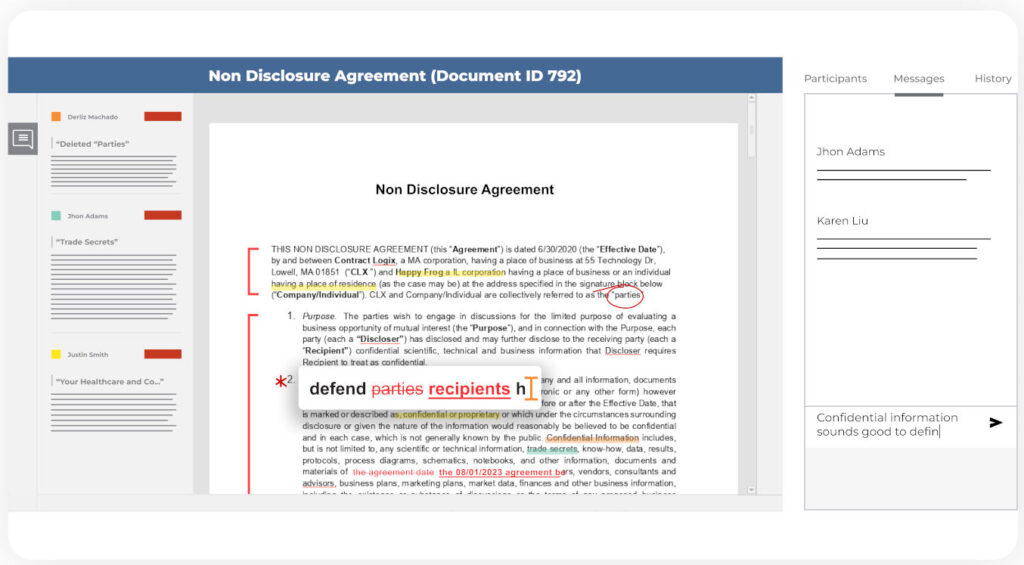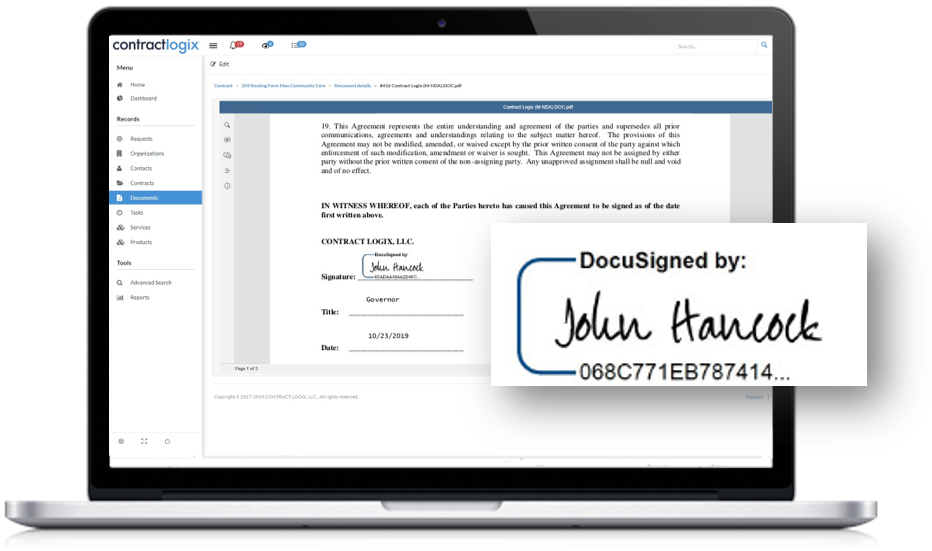What Are the Key Steps in a Successful Contract Negotiation Process?
An effective contract negotiation process ensures agreements are fair, enforceable, and beneficial for all parties. However, manual negotiation methods often lead to inefficiencies, miscommunication, and increased compliance risk. Without a structured approach, organizations may face contract disputes, missed obligations, and unnecessary financial losses.
Technology is transforming the way businesses handle contract negotiations. AI-powered tools, automated workflows, and real-time collaboration features streamline the process, improving accuracy and reducing negotiation time. By leveraging contract negotiation software, businesses can centralize contract data, enhance communication, and maintain clear version control.
This guide outlines the key steps in a successful contract negotiation process and explores how automation improves efficiency, ensures compliance, and strengthens contract outcomes.
Quick Takeaways
- Gathering relevant contract data, defining clear objectives, and leveraging automation tools set the stage for successful negotiations.
- Real-time commenting, automated version tracking, and secure access controls streamline communication and prevent mismanagement.
- AI-powered tools identify risk, track revisions, and accelerate contract approvals with eSignature integration.
- Centralized storage, automated alerts, and analytics help businesses manage obligations and optimize future contract strategies.
📌 Learn how Vitara Biomedical enhanced contract visibility, protected intellectual property, and ensured regulatory compliance with Contract Logix in this case study.
Step 1: Preparing for Negotiation
Successful contract negotiations start with thorough preparation. Without a clear strategy, businesses risk entering negotiations without leverage, leading to unfavorable terms and increased risk exposure.
Gathering Relevant Contract Data
Organizations should first collect all necessary contract information, including previous agreements, negotiation history, and key terms. AI-powered data extraction tools can automatically identify and pull key contract clauses, obligations, and financial terms, reducing manual review time.
Using contract negotiation software, businesses can centralize documents, ensuring quick access to critical details. This helps stakeholders understand existing obligations, pricing structures, and compliance requirements before discussions begin. Automating data extraction streamlines preparation, allowing negotiators to focus on strategy rather than administrative tasks.
Defining Clear Objectives
Setting clear goals prevents unnecessary back-and-forth in negotiations. Businesses should outline:
- Acceptable contract terms
- Non-negotiable clauses
- Areas where flexibility is possible
By defining these parameters upfront, organizations streamline discussions and reduce delays.
Using Automation to Identify Risk
AI-driven contract analysis helps teams detect potential risk and compliance gaps before negotiations start. Automated alerts ensure businesses address critical contract terms proactively, avoiding costly oversights.
Step 2: Streamlining Collaboration and Communication
Contract negotiations often involve multiple stakeholders, making real-time collaboration essential. Miscommunication, untracked revisions, and delays in feedback can lead to confusion and prolong negotiations.
Leveraging Real-Time Commenting and Markup Tools
Collaborating within a centralized contract management platform allows stakeholders to provide feedback directly in the document. This eliminates scattered email threads and ensures all proposed changes are documented in one place.
Maintaining Version Control to Prevent Errors
Tracking contract revisions manually can result in conflicting edits and confusion. Automated version control ensures that:
- Every change is logged and timestamped
- Previous versions are accessible if needed
- Only authorized users can approve modifications
This level of control prevents unauthorized edits and ensures a transparent negotiation process.
Ensuring Secure and Controlled Access
Granting the right permissions to the right people safeguards contract integrity. Secure access settings ensure that only authorized personnel can make modifications, protecting confidential contract terms.
Step 3: Redlining and Reviewing Contracts Efficiently
Redlining is a critical step in the contract negotiation process, allowing parties to propose changes, suggest revisions, and resolve discrepancies before finalizing an agreement.

Without a structured approach, tracking edits and managing approvals can become chaotic, leading to confusion and extended negotiation timelines.
Automating the Redlining Process
AI-powered redlining tools streamline contract review by automatically identifying potential risk, inconsistencies, and non-compliant clauses. Instead of manually searching for discrepancies, legal and procurement teams can use automated software to highlight critical areas that need attention.
Facilitating Structured Contract Edits
Using a collaboration platform ensures that all redlines and comments are captured in one place. Features like real-time markup and commenting allow internal and external stakeholders to provide feedback without disrupting workflow. This prevents version confusion and ensures a smoother review process.
Maintaining a Clear Audit Trail
Automated version control keeps a complete history of edits, approvals, and negotiations, ensuring full transparency. Businesses can track every change, reducing the risk of miscommunication and ensuring compliance with internal policies and industry regulations.
Step 4: Managing Approvals and Finalizing Contracts
Once contract terms are negotiated and agreed upon, an efficient approval process ensures that agreements move forward without unnecessary delays. Manual approval workflows often cause bottlenecks, leading to missed opportunities and extended cycle times.
Using Workflow Automation for Approvals
By implementing automated approval workflows, businesses can route contracts to the right stakeholders based on predefined rules. This ensures that:
- Approvals move forward without unnecessary delays
- Notifications alert decision-makers when action is required
- The process is standardized and compliant with internal policies
Accelerating Execution with eSignature
Electronic signature integration eliminates the need for manual signing and scanning, speeding up contract execution.

Contracts can be finalized in minutes rather than days, reducing turnaround time and improving efficiency.
Ensuring Compliance Before Signing
Before execution, businesses should perform a final compliance check to ensure all negotiated terms align with legal, financial, and operational requirements. AI-powered contract analysis can flag any last-minute discrepancies before the agreement is signed.
Step 5: Post-Negotiation Monitoring and Compliance
Executing a contract doesn’t mean the process is over. Businesses must actively monitor obligations, renewals, and compliance to ensure agreements remain beneficial and risk-free.
Storing Contracts in a Centralized Digital Repository
A contract lifecycle management (CLM) system provides a secure, searchable database for all pre- and post-execution documents. This allows teams to quickly retrieve contracts when needed, ensuring easy access to critical information.
Setting Automated Alerts for Key Obligations
Missed renewal deadlines or unfulfilled contract terms can result in penalties or lost opportunities. Automated alerts notify stakeholders about upcoming milestones, ensuring that contracts remain active and obligations are met on time.
Leveraging Analytics to Improve Future Negotiations
By tracking contract performance through reporting and analytics tools, businesses can assess past negotiations and identify areas for improvement. Understanding key trends helps refine strategies for future contract discussions.
Strengthen Your Negotiation Strategy with Today Contract Logix
A structured contract negotiation process improves efficiency, reduces risk, and ensures favorable terms for all parties. By leveraging automation, AI-driven redlining, and streamlined approvals, businesses can eliminate bottlenecks and enhance collaboration. Implementing these steps leads to faster negotiations, stronger compliance, and better contract outcomes.
Ready to optimize your contract negotiation process? Discover how Contract Logix can help your organization streamline negotiations, improve compliance, and drive better contract outcomes. Contact us or schedule a demo today!
Navigate CLM Success With Contract Logix
Download our Data Extraction Product Brief to learn how you can begin to navigate CLM success by automating the hard work using artificial intelligence with one of the best Contract Management Software’s on the market today


